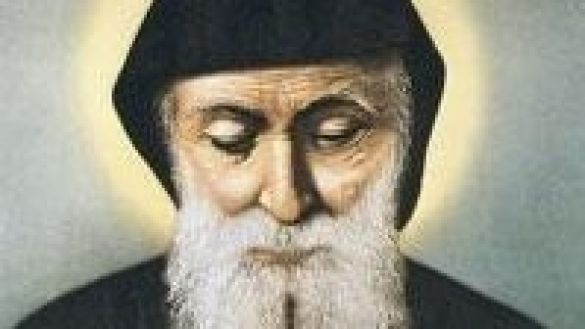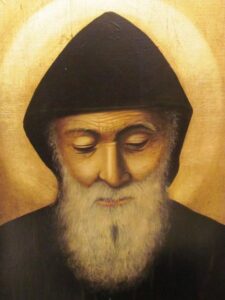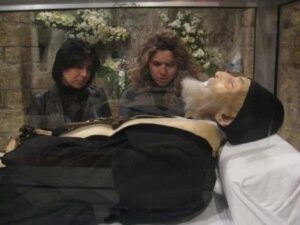
St. Sharbel Makhlouf was a Maronite priest, hermit and mystic. Youssef (Arabic for Joseph) Makhlouf was born in 1828 to a devout Maronite Catholic farming family. The Maronite Church is an Eastern Rite Church in full communion with the pope and the worldwide Catholic Church, tracing its heritage to the ancient Syriac Church. The Makhlouf family lived at Bekaa Kafra, a mountain village in northern Lebanon. As a child, Youssef attended the village school next to the parish and tended the family’s cows. His father died when Youssef was three, due to cruel forced labor at the hands of Turkish forces. His mother, a silk weaver, remarried, and the step-father was also a devout man. The family attended Mass and prayed the Rosary together daily. Even as a child, Youssef was very devout and was referred to as a little saint for his honesty and sincerity. His favorite devotion was to pray before a Marian icon at a nearby grotto, to which he would bring a candle and flowers.
INSPIRATION FROM WITHIN THE FAMILY
Two of his uncles were monks, and Youssef would make the four-hour walk to visit them at their monastery. By adulthood, he felt called to follow their example. Since his parents planned a marriage for him, he left his home on foot quietly in 1851 to join the Maronite Monastery of Our Lady of Mayfouk. Upon arrival, his name became Sharbel/Charbel after an early Church martyr.
After his first year as a novice, Sharbel was sent to the St Maroun Monastery at Annaya, Mount Lebanon to further his formation and his studies. In 1853, he made his final vows. He was sent to the ancient Monastery of St. Cyprian at Kfifane, where he continued his studies. This was the most esteemed theology school in the Maronite order, and Brother Sharbel consistently excelled in his studies. He was mentored there by [St.] Namatallah Al-Hardini, the great reformer of the Order. Brother Sharbel was ordained a priest in 1858, and returned to St. Maroun, where he lived the life of a monk for sixteen years. As a monk, he lived the daily customary prayers throughout the day and tended to the needs of the local villagers. In addition, he requested of his superiors the “heaviest and most humiliating work”, and he spent much of his days tending to the crops on the monastery’s land. He spent countless hours on his knees in prayer before the Blessed Sacrament, and fasted more than what was required.
CALLED TO SOLITUDE

By 1875, Father Sharbel had discerned a call to the unique life of a hermit, a life of solitude, prayer, and penance. He requested of his superior to be released from the monastery to live his remaining days at the hermitage of Sts. Peter and Paul at Annaya, near the monastery. Permission was not granted at first, since the capacity for three hermits was already occupied. After his lamp was observed burning for hours despite having no oil, permission was indeed granted.
Life as a hermit for Father Sharbel was peaceful but very penitential. He ate little, slept little, and spent his days in prayer and manual labor. He wore a hair shirt, slept on the hard ground and practiced several other bodily mortifications. He lived thus for twenty-three years. Occasionally, he was asked by his superiors to visit someone in great need of healing, and he became known as a man of miracles. He was also known to levitate while praying and could cast out demons. On December 16, 1898, Father was offering Mass in the chapel when he suffered a stroke at the moment of the Major Elevation (when the Eucharist is being offered to God the Father). He dropped to the floor, still tightly holding the Host. He was paralyzed, yet still able to speak. While his companions carried him to his cell, he continued to utter his last liturgical words, “Father of truth, behold Your Son, a sacrifice pleasing to You. Accept the offering. He died for me that I might have life. Behold the offering!” He suffered for eight days and died on Christmas Eve at the age of seventy.
MAN OF MIRACLES

Much of St. Sharbel’s story takes place after his death. His body was placed in a wet wooden pit with the remains of other monks, according to the custom of the Order. Beginning on the very evening of his burial, a brilliant light shone at night from the tomb. Four months later, his body was discovered to be incorrupt and transferred to a coffin in the chapel. For sixty-five years, the body remained incorrupt and exuded a substance made of perspiration and blood, but which had a pleasant smell. After his 1965 beatification, the remains decomposed. In 1950, the monastery began keeping track of the miracles attributed to his intercession. By his 1977 canonization, more than 130,000 unexplainable healings in 95 countries had taken place. On the day of St. Sharbel’s death, his superior, Fr. Antonios Mishmeshani, wrote the following in the monastery journal, “…Because of that which he will do after his death, I need not give any details of his life. Faithful to his vows, and of exemplary obedience, his conduct was more angelic than human”. Indeed, St. Sharbel gave his entire life over as an oblation in atonement for sin and on behalf of sinners. His shrine at the Annaya monastery has been visited by millions of pilgrims, and he is the patron of Lebanon. His feast day on the Roman calendar is July 24.
